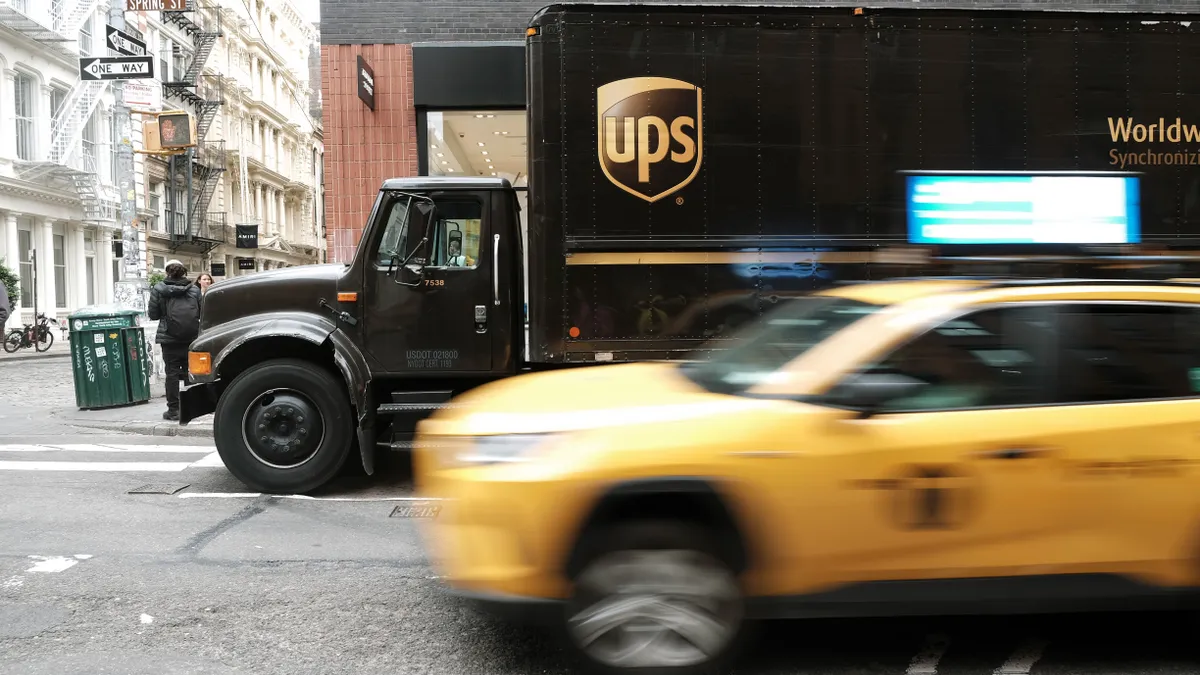UPS surcharges on certain packages will stick around beyond peak season, albeit at a lower cost, according to a UPS customer update.
Updated "demand surcharges" targeting large shipper volume spikes and hard-to-handle packages will take effect Jan. 15 and remain active until further notice. The fees replace peak season surcharges that began Oct. 30.
The mechanics of the upcoming surcharges mirror those implemented during UPS' 2022 peak season, but shippers will pay lower fees per applicable package. For the company's Air Residential, Ground Residential and SurePost services, a demand surcharge applies on a weekly basis to every package over 105% of a customer's baseline volume.
UPS per-package demand surcharge, based on percentage over shipper's baseline volume
| >105% to 125% | >125% to 150% | >150% | |
|---|---|---|---|
| UPS SurePost, Ground Residential (Ending Jan. 14) | $1.25 | $1.75 | $2.00 |
| UPS SurePost, Ground Residential (Starting Jan. 15) | $0.40 | $0.50 | $0.60 |
| UPS Air Residential (Ending Jan. 14) | $2.25 | $2.75 | $3.00 |
| UPS Air Residential (Starting Jan. 15) | $0.40 | $0.50 | $0.60 |
NOTE: The surcharges ending Jan. 14 began on Oct. 30, 2022 and increase further for volume over 200% of a customer's baseline.
The baseline is the customer's average weekly volume from June 5 to July 2, 2022. However, UPS will use the average weekly volume from Sept. 4 to Oct. 2, 2022 instead if it is less than 80% of the prior period's volume.
UPS will charge shippers the highest applicable surcharge amount for all volumes exceeding a shipper’s calculated baseline. It only applies to customers who are billed for more than 20,000 packages for any week following October 2021.
Additional handling and large package surcharges for U.S. domestic, U.S. import and U.S. export shipments will continue to apply for qualifying UPS customers. Starting Jan. 15, the additional handling surcharge will drop from the $6.50 per-package fee during peak to $3.50. For large packages, the fee will decrease from $70 to $40.
"Our surcharges help protect our network and ensure UPS receives appropriate compensation for additional costs to maintain our high-quality service against the backdrop of dynamic market conditions," UPS said in an emailed statement.
But Josh Taylor, Shipware senior director of professional services, said the new round of fees is about UPS improving its bottom line rather than covering unavoidable costs.
“With actual demand down year-over-year and diesel costs predicted to drop, the post-peak residential ‘demand surcharge’ is UPS finding an additional way to drive profits without delivering more value,” he said.
Rival FedEx is also chasing more profitability per delivered package as the pandemic-fueled surge in demand cools off. Both carriers have continued to levy surcharges while implementing larger annual rate increases, which they say will keep service levels high and help them endure inflationary pressures.
“Look for FedEx to follow once their systems can deliver it,” Taylor said in reference to the UPS demand surcharge.
In a LinkedIn post, LPF Spend Management founder Nate Skiver said the combination of contractual revenue commitments and surcharges allows UPS to increase its revenue per package. Renegotiating contracts and considering alternative carriers were among his recommendations for shippers.
"A key consideration is the continued residential (and SurePost) volume threshold requirements," Skiver said. "UPS can modify these requirements at any time. This allows for quasi-dynamic pricing. It makes complex pricing more difficult for customers to manage."













